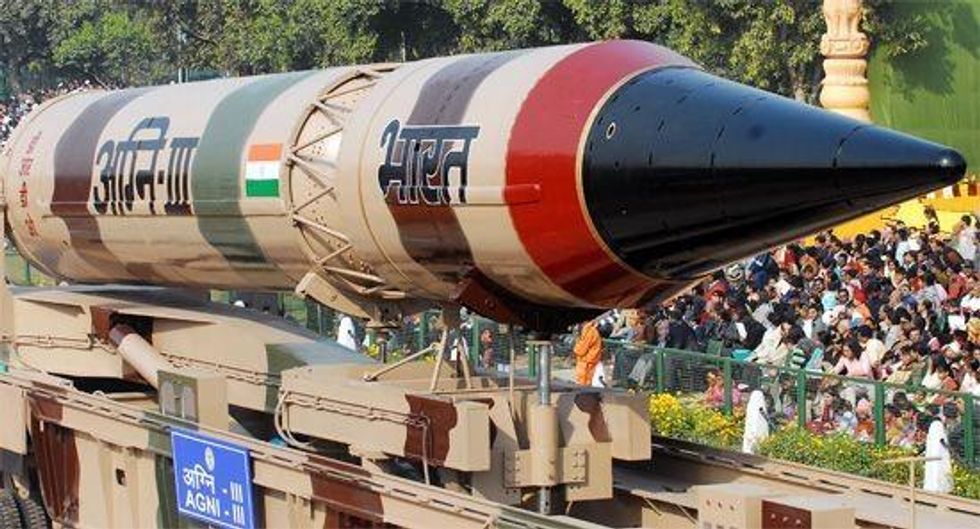The Nuclear New-Boy we Should be Watching is India
While the United States beats the war drums over North Korea and Iran's long-ranged nuclear armed missiles -which they don't even possess - Washington remains curiously silent about the arrival of the world's newest member of the big nuke club - India.
While the United States beats the war drums over North Korea and Iran's long-ranged nuclear armed missiles -which they don't even possess - Washington remains curiously silent about the arrival of the world's newest member of the big nuke club - India.

These new nuclear subs and their SLBM's will give India the capability to strike many high-value targets around the globe. Equally important, they complete India's nuclear triad of nuclear weapons delivered by aircraft, missiles, and now sea that will be invulnerable to a decapitating first strike from either Pakistan or China.
Last February, it was revealed that India is fast developing a new, long-ranged, three-stage ballistic missile, Agni-VI. This powerful missile is said to be able to carry up to ten independently targetable nuclear warheads, known as MIRV's.
Agni-VI's range is believed to be at least 10,000km,
putting all of China, Japan, Australia, and Russia in its range. A new 15,000km missile capable of hitting North America is also in the works under cover of India's civilian space program. India is also developing accurate cruise missiles and miniaturized nuclear warheads to fit into their small diameter.
These important strategic developments will put India ahead of other nuclear powers France, Britain, North Korea, and Pakistan, about equal in striking power to Israel and China, and not too far behind the United States and Russia.
Delhi says it needs a nuclear triad because of the growing threat of China, whose conventional and nuclear forces are being rapidly modernized.
This writer has been reporting on the nuclear arms race between India and China since the late 1990's. China has replaced Pakistan as India's primary nuclear threat. Even so, Indian and Pakistani nuclear forces remain on a frightening hair-trigger alert within only a 3-5 minute warning time of enemy attack, making the Kashmir cease-fire line (or Line of Control) the world's most dangerous border.
The Bush administration began quietly aiding India's nuclear program with nuclear fuel when India had a shortage of fissile material. Some advanced technology from the US and India's second largest arms supplier, Israel, has also aided Delhi's nuclear and missile delivery programs.
India, as I wrote years ago after one of its big nuclear tests, is feeling its "nuclear Viagra." Most Indians take great pride in their strategic nuclear programs as their way into the great power's exclusive nuclear club.
But not all Indians are so delighted, particularly those on the left who ask how their nation, with one third of all the world's poorest people, can afford to spend tens of billions on advanced weapons, including nuclear submarines, aircraft carriers, and ICBM's.
According to the World Bank, 32.7% of Indians subsist below the international poverty level of $1.25 daily, and 68.7% on less than $2 daily. Aid agencies say 33% of Indian children are malnourished.
Delhi is making steady progress in reducing poverty and disease, and in trying to break down the pernicious caste system that dooms a quarter of Indians to lives of misery.
This, critics claim, is no time to be posturing as a world power when Mother India still has feet of clay.
The Bush administration was totally unaware that India's advent as a major nuclear power whose weapons might one day challenge the United States. Bush & Co. wanted India to bulk up as a competitor to China, a permanent enemy of the Republican hard right. Today's Republicans think similarly.
India is a great democracy where politicians, not generals, make policy. She is a staunch friend of the United States, where over one million Indians now live. True enough, but we have seen there are no permanent friends in world politics, only permanent interests.
One day mighty India may vie for influence with the US for Mideast and Central Asian oil, and control of the Indian Ocean's vital sea lanes. But not today, as all eyes are on pipsqueak North Korea and dilapidated Iran.
An Urgent Message From Our Co-Founder
Dear Common Dreams reader, The U.S. is on a fast track to authoritarianism like nothing I've ever seen. Meanwhile, corporate news outlets are utterly capitulating to Trump, twisting their coverage to avoid drawing his ire while lining up to stuff cash in his pockets. That's why I believe that Common Dreams is doing the best and most consequential reporting that we've ever done. Our small but mighty team is a progressive reporting powerhouse, covering the news every day that the corporate media never will. Our mission has always been simple: To inform. To inspire. And to ignite change for the common good. Now here's the key piece that I want all our readers to understand: None of this would be possible without your financial support. That's not just some fundraising cliche. It's the absolute and literal truth. We don't accept corporate advertising and never will. We don't have a paywall because we don't think people should be blocked from critical news based on their ability to pay. Everything we do is funded by the donations of readers like you. Will you donate now to help power the nonprofit, independent reporting of Common Dreams? Thank you for being a vital member of our community. Together, we can keep independent journalism alive when it’s needed most. - Craig Brown, Co-founder |
While the United States beats the war drums over North Korea and Iran's long-ranged nuclear armed missiles -which they don't even possess - Washington remains curiously silent about the arrival of the world's newest member of the big nuke club - India.

These new nuclear subs and their SLBM's will give India the capability to strike many high-value targets around the globe. Equally important, they complete India's nuclear triad of nuclear weapons delivered by aircraft, missiles, and now sea that will be invulnerable to a decapitating first strike from either Pakistan or China.
Last February, it was revealed that India is fast developing a new, long-ranged, three-stage ballistic missile, Agni-VI. This powerful missile is said to be able to carry up to ten independently targetable nuclear warheads, known as MIRV's.
Agni-VI's range is believed to be at least 10,000km,
putting all of China, Japan, Australia, and Russia in its range. A new 15,000km missile capable of hitting North America is also in the works under cover of India's civilian space program. India is also developing accurate cruise missiles and miniaturized nuclear warheads to fit into their small diameter.
These important strategic developments will put India ahead of other nuclear powers France, Britain, North Korea, and Pakistan, about equal in striking power to Israel and China, and not too far behind the United States and Russia.
Delhi says it needs a nuclear triad because of the growing threat of China, whose conventional and nuclear forces are being rapidly modernized.
This writer has been reporting on the nuclear arms race between India and China since the late 1990's. China has replaced Pakistan as India's primary nuclear threat. Even so, Indian and Pakistani nuclear forces remain on a frightening hair-trigger alert within only a 3-5 minute warning time of enemy attack, making the Kashmir cease-fire line (or Line of Control) the world's most dangerous border.
The Bush administration began quietly aiding India's nuclear program with nuclear fuel when India had a shortage of fissile material. Some advanced technology from the US and India's second largest arms supplier, Israel, has also aided Delhi's nuclear and missile delivery programs.
India, as I wrote years ago after one of its big nuclear tests, is feeling its "nuclear Viagra." Most Indians take great pride in their strategic nuclear programs as their way into the great power's exclusive nuclear club.
But not all Indians are so delighted, particularly those on the left who ask how their nation, with one third of all the world's poorest people, can afford to spend tens of billions on advanced weapons, including nuclear submarines, aircraft carriers, and ICBM's.
According to the World Bank, 32.7% of Indians subsist below the international poverty level of $1.25 daily, and 68.7% on less than $2 daily. Aid agencies say 33% of Indian children are malnourished.
Delhi is making steady progress in reducing poverty and disease, and in trying to break down the pernicious caste system that dooms a quarter of Indians to lives of misery.
This, critics claim, is no time to be posturing as a world power when Mother India still has feet of clay.
The Bush administration was totally unaware that India's advent as a major nuclear power whose weapons might one day challenge the United States. Bush & Co. wanted India to bulk up as a competitor to China, a permanent enemy of the Republican hard right. Today's Republicans think similarly.
India is a great democracy where politicians, not generals, make policy. She is a staunch friend of the United States, where over one million Indians now live. True enough, but we have seen there are no permanent friends in world politics, only permanent interests.
One day mighty India may vie for influence with the US for Mideast and Central Asian oil, and control of the Indian Ocean's vital sea lanes. But not today, as all eyes are on pipsqueak North Korea and dilapidated Iran.
While the United States beats the war drums over North Korea and Iran's long-ranged nuclear armed missiles -which they don't even possess - Washington remains curiously silent about the arrival of the world's newest member of the big nuke club - India.

These new nuclear subs and their SLBM's will give India the capability to strike many high-value targets around the globe. Equally important, they complete India's nuclear triad of nuclear weapons delivered by aircraft, missiles, and now sea that will be invulnerable to a decapitating first strike from either Pakistan or China.
Last February, it was revealed that India is fast developing a new, long-ranged, three-stage ballistic missile, Agni-VI. This powerful missile is said to be able to carry up to ten independently targetable nuclear warheads, known as MIRV's.
Agni-VI's range is believed to be at least 10,000km,
putting all of China, Japan, Australia, and Russia in its range. A new 15,000km missile capable of hitting North America is also in the works under cover of India's civilian space program. India is also developing accurate cruise missiles and miniaturized nuclear warheads to fit into their small diameter.
These important strategic developments will put India ahead of other nuclear powers France, Britain, North Korea, and Pakistan, about equal in striking power to Israel and China, and not too far behind the United States and Russia.
Delhi says it needs a nuclear triad because of the growing threat of China, whose conventional and nuclear forces are being rapidly modernized.
This writer has been reporting on the nuclear arms race between India and China since the late 1990's. China has replaced Pakistan as India's primary nuclear threat. Even so, Indian and Pakistani nuclear forces remain on a frightening hair-trigger alert within only a 3-5 minute warning time of enemy attack, making the Kashmir cease-fire line (or Line of Control) the world's most dangerous border.
The Bush administration began quietly aiding India's nuclear program with nuclear fuel when India had a shortage of fissile material. Some advanced technology from the US and India's second largest arms supplier, Israel, has also aided Delhi's nuclear and missile delivery programs.
India, as I wrote years ago after one of its big nuclear tests, is feeling its "nuclear Viagra." Most Indians take great pride in their strategic nuclear programs as their way into the great power's exclusive nuclear club.
But not all Indians are so delighted, particularly those on the left who ask how their nation, with one third of all the world's poorest people, can afford to spend tens of billions on advanced weapons, including nuclear submarines, aircraft carriers, and ICBM's.
According to the World Bank, 32.7% of Indians subsist below the international poverty level of $1.25 daily, and 68.7% on less than $2 daily. Aid agencies say 33% of Indian children are malnourished.
Delhi is making steady progress in reducing poverty and disease, and in trying to break down the pernicious caste system that dooms a quarter of Indians to lives of misery.
This, critics claim, is no time to be posturing as a world power when Mother India still has feet of clay.
The Bush administration was totally unaware that India's advent as a major nuclear power whose weapons might one day challenge the United States. Bush & Co. wanted India to bulk up as a competitor to China, a permanent enemy of the Republican hard right. Today's Republicans think similarly.
India is a great democracy where politicians, not generals, make policy. She is a staunch friend of the United States, where over one million Indians now live. True enough, but we have seen there are no permanent friends in world politics, only permanent interests.
One day mighty India may vie for influence with the US for Mideast and Central Asian oil, and control of the Indian Ocean's vital sea lanes. But not today, as all eyes are on pipsqueak North Korea and dilapidated Iran.

